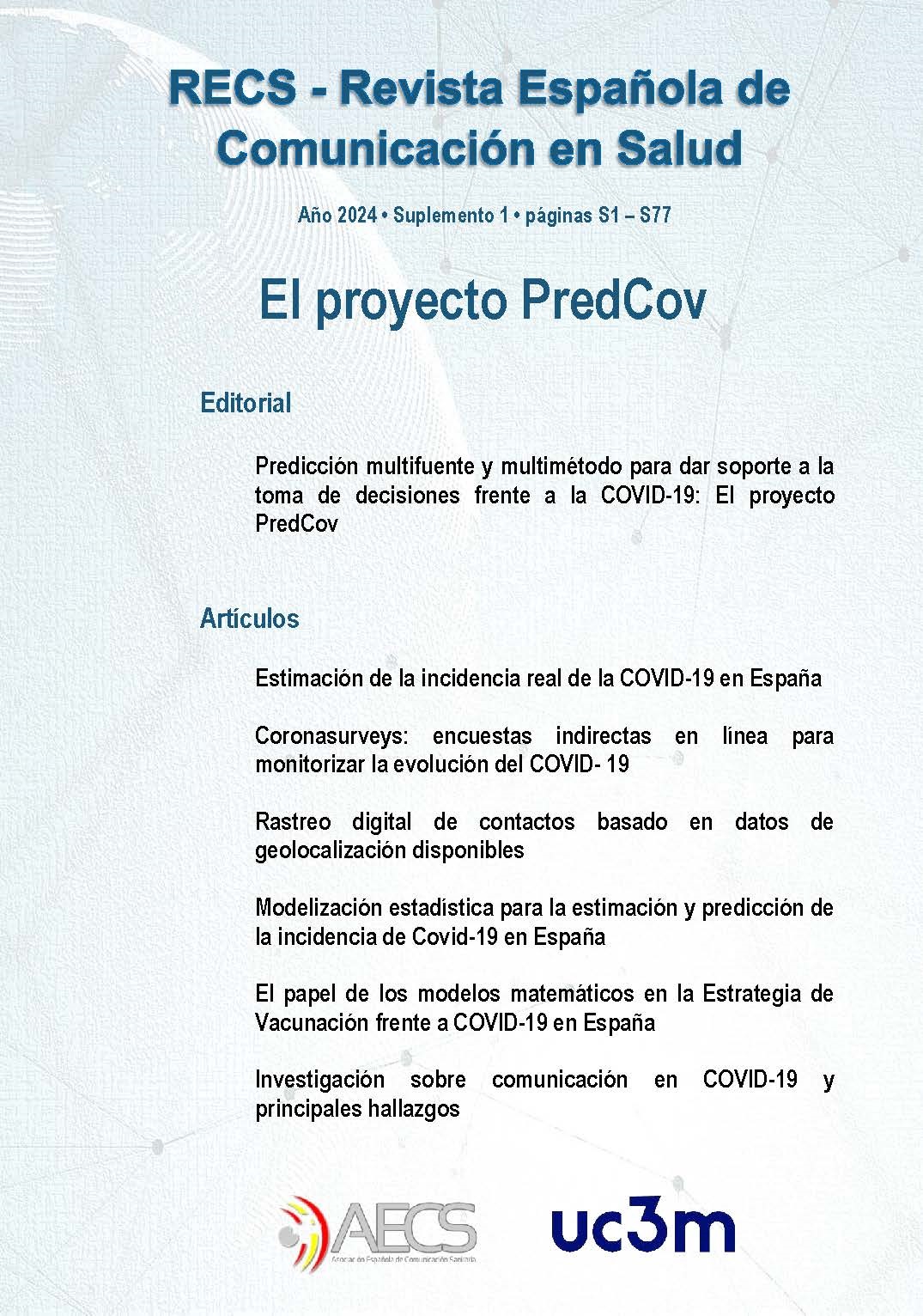Rastreo digital de contactos
Datos de geolocalización a gran escala como alternativa al fracaso de las aplicaciones basadas en Bluetooth Digital
DOI:
https://doi.org/10.20318/recs.2024.7687Palabras clave:
COVID-19, rastreo de contactos, Facebook, Google, geolocalización, privacidadResumen
Introducción: Las aplicaciones móviles de rastreo de contactos desplegadas actualmente han fracasado como solución eficaz en el contexto de la pandemia COVID-19. Ninguna de ellas ha conseguido atraer al número de usuarios activos necesario para lograr una operación eficiente. Objetivo: ampliar la definición de los sistemas digitales de rastreo de contactos. Metodología: Se ha propuesto un protocolo para el rastreo de contactos utilizando información de proveedores de localización. Dicho protocolo ha sido implementado, y se ha medido su rendimiento. Resultados: la solución ha sido implementada, la cual además de ser eficiente garantiza la privacidad de los usuarios Conclusión: La solución presentada permitiría el rastreo de contactos, y con suficiente eficiencia para que escale correctamente.
Descargas
Referencias
Aleta, A., Martín-Corral, D., Bakker, M. A., Piontti, A. P. y., Ajelli, M., Litvinova, M., . . . Moro, E. (2020) Quantifying the importance and location of SARS-CoV-2 transmission events in large metropolitan areas. medRxiv. Retrieved from https://www.medrxiv.org/content/early/2020/12/17/2020.12.15.20248273 doi: 10.1101/2020.12.15.20248273
Apple and Google. (2021). Exposure Notifications: Using technology to help public health authori- ties fight COVID-19. (Accessed on: February 26, 2021. https://www.google.com/covid19/exposurenotifications/)
Data World Bank. (2020). Total Population. (Accessed on: December 27, 2020 https://data.worldbank.org/indicator/SP.POP.TOTL)
Demographics of Mobile Device Ownership and Adoption in the United States. (2020, Jun). Pew Research Center. (Accessed on: December 27, 2020 https://www.pewresearch.org/internet/fact-sheet/mobile/)
Dimoco. (2020, 04). Market Insights. (Accessed on: December 27, 2020 https://dimoco.eu/carrierbilling/coverage/)
EU. (2016). Regulation (EU) 2016/679 of the European Parliament (General Data Protection Regulation). European Union. (Accessed on: April 22, 2020 http://eur-lex.europa.eu/eli/reg/2016/679/oj)
Facebook. (2020). Facebook Marketing API. (Accessed on: December 27, 2020 https://developers.facebook.com/docs/marketing-apis)
FDVT. (2021, 02). Contact tracing apps: number of downloads sources across countries. (Accessed on: February 28, 2021 https://fdvt.org/files/COVID APPS SOURCES.pdf)
Ferretti, L., Wymant, C., Kendall, M., Zhao, L., Nurtay, A., Abeler-Do¨rner, L., . . . Fraser, C. (2020). Quantify- ing SARS-CoV-2 transmission suggests epidemic control with digital contact tracing. Science, 368(6491). Retrieved from https://science.sciencemag.org/content/368/6491/eabb6936 doi: 10.1126/science.abb6936
Google. (2020, Mar). Wi-Fi location: ranging with RTT. (Accessed on: April 20, 2020 https://developer.android.com/guide/topics/connectivity/wifi-rtt)
GPS.gov. (2017, Dec). GPS Accuracy. (Accessed on: April 20, 2020 https://www.gps.gov/systems/gps/performance/accuracy/)
Hinch et al., R. (2020). Effective configurations of a digital contact tracing app: A report to NHSX. GitHub. (https://github.com/BDI-pathogens/covid-19_instant_tracing/blob/master/Report%20-%20Effective%20Configurations%20of%20a%20Digital%20Contact%20Tracing%20App.pdf)
Lednicky, J. A., Lauzardo, M., Fan, Z. H., Jutla, A., Tilly, T. B., Gangwar, M., . . . Wu, C.-Y. (2020). Viable SARS-CoV-2 in the air of a hospital room with COVID-19 patients. medRxiv. Retrieved from https://www.medrxiv.org/content/early/2020/08/04/2020.08.03.20167395 doi: 10.1101/2020.08.03.20167395
Mokbel, M., Abbar, S., & Stanojevic, R. (2020, October). Contact Tracing: Beyond the Apps. SIGSPATIAL Special, 12(2), 15–24. Retrieved from https://doi.org/10.1145/3431843.3431846 doi: 10.1145/3431843.3431846
Nakamoto, I., Wang, S., Guo, Y., & Zhuang, W. (2020). A QR Code–Based Contact Tracing Framework for Sustainable Containment of COVID-19: Evaluation of an Approach to Assist the Return to Normal Activity. JMIR mHealth and uHealth, 8(9), e22321.
Prather, K. A., Marr, L. C., Schooley, R. T., McDiarmid, M. A., Wilson, M. E., & Milton, D. K. (2020). Airborne trans- mission of SARS-CoV-2. Science, 370(6514), 303–304. Retrieved from https://science.sciencemag.org/content/370/6514/303.2 doi: 10.1126/science.abf0521
Rahman, M. T., Khan, R. T., Khandaker, M. R., Sellathurai, M., & Salan, M. S. A. (2020). An automated contact tracing approach for controlling COVID-19 spread based on geolocation data from mobile cellular networks. IEEE Access, 8, 213554–213565.
Reichert, L., Brack, S., & Scheuermann, B. (2020). Privacy-Preserving contact tracing of COVID-19 patients.IACR Cryptol. ePrint Arch., 2020, 375.
Rodríguez, P., Graña, S., Alvarez-León, E. E., Battaglini, M., Darias, F. J., Hernán, M. A., . . . others (2021). A population-based controlled experiment assessing the epidemiological impact of digital contact tracing. Nature communications, 12(1), 1–6.
Salathé, M., Althaus, C. L., Anderegg, N., Antonioli, D., Ballouz, T., Bugnion, E., . . . von Wyl,V. (2020). Early Evidence of Effectiveness of Digital Contact Tracing for SARS-CoV-2 in Switzerland. medRxiv. Retrieved from https://www.medrxiv.org/content/early/2020/10/04/2020.09.07.20189274 doi: 10.1101/2020.09.07.20189274
Scientific Brief: SARS-CoV-2 and Potential Airborne Transmission. (2020, Oct). Centers for Disease Control and Prevention (CDC). (Accessed on: December 27, 2020 https://www.cdc.gov/coronavirus/2019-ncov/more/scientific-brief-sars-cov-2.html)
StatCounter Global Stats. (2020). Mobile Operating System Market Share Worldwide. (Accessed on: December 27, 2020 https://gs.statcounter.com/os-market-share/mobile/)
StraitTimes. (2020, April). Call for more people to use contact-tracing app. (Accessed on: April 20, 2020 https://www.straitstimes.com/singapore/call-for-more-people-to-use-contact-tracing-app)
Swiss Federal Statistical Office. (2020). Swiss Covid App Monitoring. (Accessed on: December 27, 2020 https://www.experimental.bfs.admin.ch/expstat/en/home/innovative-methods/swisscovid-app-monitoring.assetde-tail.13407769.html)
Wymant, C., Ferretti, L., Tsallis, D., Charalambides, M., Abeler-Dörner, L., Bonsall, D., . . . others (2021). The epidemiological impact of the NHS COVID-19 App. Alan Turing Institute.
Descargas
Publicado
Número
Sección
Licencia
Los textos publicados en esta revista están –si no se indica lo contrario– bajo una licencia Reconocimiento-Sin obras derivadas 3.0 España de Creative Commons. Puede copiarlos, distribuirlos y comunicarlos públicamente siempre que cite su autor y la revista y la institución que los publica y no haga con ellos obras derivadas. La licencia completa se puede consultar en: http://creativecommons.org/licenses/by-nd/3.0/es/deed.es
Los derechos de autor pertenecen al autor de la obra por el mero hecho de su creación:
· Los derechos de contenido moral son irrenunciables e inalienables.
· Los derechos de contenido económico, o derechos de explotación, pueden ser cedidos a terceros como ocurre con los trabajos publicados, en los que el autor cede parte o la totalidad de estos derechos a la editorial.
El autor puede autoarchivar sus artículos en un repositorio institucional, siempre que se cite su publicación en esta revista.
